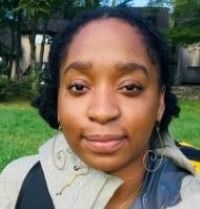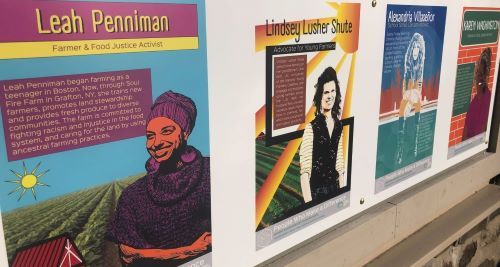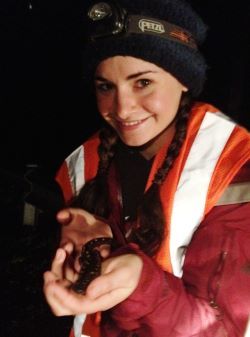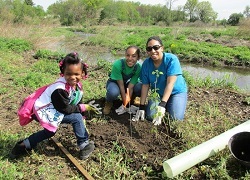In This Issue:
- Women in Science Webinar Feb. 10 at 3 p.m.
- Amphibian Migrations & Road Crossings Training Feb. 10 at 4:30 p.m.
- Apply Now for Hudson Estuary Trees for Tribs Spring Planting Projects
Underrepresented Environmental Heroes: Webinar Feb. 10, 3 p.m. - 4 p.m.
 Join Kate Phipps and Preyah James as they discuss Scenic Hudson’s People Who Make a Difference poster series and the importance of a diverse representation of environmental role models. Learn how to engage and inspire your students with today's environmental heroes. This Women in Science webinar takes place Wednesday, February 10 from 3 p.m. – 4 p.m. Register now. Join Kate Phipps and Preyah James as they discuss Scenic Hudson’s People Who Make a Difference poster series and the importance of a diverse representation of environmental role models. Learn how to engage and inspire your students with today's environmental heroes. This Women in Science webinar takes place Wednesday, February 10 from 3 p.m. – 4 p.m. Register now.
Kate Phipps is the Education and Community Engagement Coordinator at Scenic Hudson. She develops lesson plans and teaches on a range of topics including climate change and invasive species, Hudson River ecology and water quality, and environmental and food justice. Kate helps educators enrich their teaching with place-based, hands-on, and student-focused topics that provide opportunities for students to connect with the environment around them.
 Preyah James is an alumnus of the Student Conservation Association’s Hudson Valley Corps, and the former Education and Community Engagement Assistant for Scenic Hudson. During her two-year tenure with Scenic Hudson, Preyah had the opportunity to engage Hudson Valley youth in educational opportunities based in ecology, conservation, food justice, and environmental activism. Preyah is dedicated to promoting diversity and inclusion in the sciences and encouraging young people to get involved in environmental studies. Preyah James is an alumnus of the Student Conservation Association’s Hudson Valley Corps, and the former Education and Community Engagement Assistant for Scenic Hudson. During her two-year tenure with Scenic Hudson, Preyah had the opportunity to engage Hudson Valley youth in educational opportunities based in ecology, conservation, food justice, and environmental activism. Preyah is dedicated to promoting diversity and inclusion in the sciences and encouraging young people to get involved in environmental studies.
Save the Date:
The next Women in Science Webinar will be held Wednesday, February 24, 3 p.m. - 4 p.m. Shinara Sunderlal, conservation educator with the Wildlife Conservation Society, New York Aquarium, will discuss her work.

Amphibian Migrations & Road Crossings Training for Volunteers Feb. 10
 On rainy spring nights when weather conditions are right, large numbers of salamanders and frogs emerge from winter hibernation in the forest and make their way to woodland pools, where they'll mate and lay eggs. Many migrating amphibians need to cross roads to reach these vernal pools. The Amphibian Migrations and Road Crossings Project enlists volunteers to find locations in the Hudson Valley where migrations cross roads; document weather and traffic conditions; record migrating amphibians; and help them across the road. On rainy spring nights when weather conditions are right, large numbers of salamanders and frogs emerge from winter hibernation in the forest and make their way to woodland pools, where they'll mate and lay eggs. Many migrating amphibians need to cross roads to reach these vernal pools. The Amphibian Migrations and Road Crossings Project enlists volunteers to find locations in the Hudson Valley where migrations cross roads; document weather and traffic conditions; record migrating amphibians; and help them across the road.
Are you interested in volunteering? The Amphibian Migrations & Road Crossings (AM&RC) Project is offering an online training program on Wednesday, February 10, 4:30 p.m. - 6 p.m. This session will serve as an introduction to new participants and a refresher for returning volunteers. If you’ve never attended an AM&RC training, we strongly encourage you to watch the recorded training modules on YouTube for more in-depth instruction and information, prior to the online program.
The training on February 10 will include:
- overview of how to volunteer
- data collection methods
- safety tips
- ideas for local coordination from program partners.
We also hope to include virtual “breakout rooms” so that volunteers from different parts of the Hudson estuary watershed can connect with one another. Register for the program now. If you have any questions, please contact Emma at emma.clements@dec.ny.gov.

Hudson Estuary Trees for Tribs: Apply Now for Spring Planting
 Do you own or manage land along a stream? DEC's Hudson Estuary Trees for Tribs provides free native plants to help reduce erosion and improve habitat along the tributary streams in the Hudson River Estuary watershed. Projects must use more than 60 plants. Our staff can help you with a planting plan and work with your volunteers. Do you own or manage land along a stream? DEC's Hudson Estuary Trees for Tribs provides free native plants to help reduce erosion and improve habitat along the tributary streams in the Hudson River Estuary watershed. Projects must use more than 60 plants. Our staff can help you with a planting plan and work with your volunteers.
Applicants must complete an application, and if the project is selected, recruit volunteers for planting, and maintain the site after the planting is complete. Watch a video about Trees for Tribs on DEC's YouTube page to see how the program works for landowners and land managers. The application deadline is March 1 for a spring planting. For more information about the program or to download an application, please visit DEC's Hudson Estuary Trees for Tribs website.
|


 Join Kate Phipps and Preyah James as they discuss Scenic Hudson’s People Who Make a Difference poster series and the importance of a diverse representation of environmental role models. Learn how to engage and inspire your students with today's environmental heroes. This Women in Science webinar takes place Wednesday, February 10 from 3 p.m. – 4 p.m.
Join Kate Phipps and Preyah James as they discuss Scenic Hudson’s People Who Make a Difference poster series and the importance of a diverse representation of environmental role models. Learn how to engage and inspire your students with today's environmental heroes. This Women in Science webinar takes place Wednesday, February 10 from 3 p.m. – 4 p.m.  Preyah James is an alumnus of the
Preyah James is an alumnus of the 
 On rainy spring nights when weather conditions are right, large numbers of salamanders and frogs emerge from winter hibernation in the forest and make their way to woodland pools, where they'll mate and lay eggs. Many migrating amphibians need to cross roads to reach these vernal pools. The
On rainy spring nights when weather conditions are right, large numbers of salamanders and frogs emerge from winter hibernation in the forest and make their way to woodland pools, where they'll mate and lay eggs. Many migrating amphibians need to cross roads to reach these vernal pools. The 
 Do you own or manage land along a stream?
Do you own or manage land along a stream?